| Daihatsu Move | |
|---|---|
 Daihatsu Move Custom RS Turbo (LA100S) | |
| Overview | |
| Manufacturer | Daihatsu |
| Also called |
|
| Production | August 1995 – present |
| Body and chassis | |
| Class | |
| Body style | 5-door hatchback |
| Layout | |
The Daihatsu Move (Japanese: ダイハツ・ムーヴ, Daihatsu Mūvu) is a kei car/city car manufactured by the Japanese automaker Daihatsu since August 1995. The Move is Daihatsu's response to the similarly designed Suzuki Wagon R that was introduced two years earlier in 1993. The Move is built upon the chassis of the Mira but with a taller body.
First generation (L600; 1995)
| First generation (L600) | |
|---|---|
 Daihatsu Move (L600S) | |
| Overview | |
| Production | August 1995 – October 1998 |
| Designer | I.DE.A Institute |
| Body and chassis | |
| Related | Daihatsu Mira (L500) |
| Powertrain | |
| Engine | |
| Transmission | |
| Dimensions | |
| Wheelbase | 2,300 mm (90.6 in) |
| Length | 3,295 mm (129.7 in) |
| Width | 1,395 mm (54.9 in) |
| Height | 1,620 mm (63.8 in) |
| Kerb weight | 690–800 kg (1,521–1,764 lb) |
The first-generation Move was designed by I.DE.A in Turin, Italy.[1] It was marketed with a 659 cc three-cylinder engine in Japan and with an 847 cc (51.7 cu in) ED-20 engine in export markets. The Japanese domestic market models were internally designated L600, or L610 when equipped with four-wheel drive system; export models were internally designated L601. In 1997, a variant marketed as the Move Custom was introduced with larger headlamps and revised front styling, and was available in subsequent generations.
Daihatsu produced more than half a million L600/L610 Move models, mostly in Japan. It was imported to Europe, including the UK; its 1999 successor was not exported to Europe.
The Move was also offered with the turbocharged 659 cc JB-JL all-aluminium four-cylinder engine producing 64 PS (47 kW; 63 hp) and using the internal designation L602; this version was only available with front-wheel drive.[2] This four-cylinder version was originally the only version of the Move which was available with a four-speed automatic transmission; in May 1996 this became available with the turbocharged three-cylinder engine and proceeded to gradually spread downwards through the grades. The export model's ED-20 engine produced 44 PS (32 kW; 43 hp), offering more torque than the naturally aspirated 660 cc engines thanks to the larger displacement. The turbocharged engine was not offered in Europe due to its excessive emissions.[1] The export model has a top speed of 130 km/h (81 mph), 125 km/h (78 mph) in the version with an automatic transmission.
 Daihatsu Move Z4 (L610S)
Daihatsu Move Z4 (L610S) Daihatsu Move SR Turbo (L600S)
Daihatsu Move SR Turbo (L600S)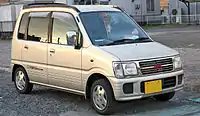 Daihatsu Move Custom (L600S)
Daihatsu Move Custom (L600S) Daihatsu Move Custom (L600S)
Daihatsu Move Custom (L600S) Export-model Daihatsu Move
Export-model Daihatsu Move
Second generation (L900; 1998)
| Second generation (L900) | |
|---|---|
 1998 Daihatsu Move SR-XX (L900S) | |
| Overview | |
| Also called | Huali Happy Messenger (China, 2003–2008) Miles ZX40 (United States, 2006–2013) Perodua Kenari (Malaysia, 2000–2009) |
| Production | 1998–2002 (Japan) 2003–2008 (Huali) 2006–2013 (Miles) 2000–2009 (Kenari) |
| Designer | Italdesign Giugiaro |
| Body and chassis | |
| Related | |
| Powertrain | |
| Engine | |
| Power output |
|
| Transmission |
|
| Dimensions | |
| Wheelbase | 2,360 mm (92.9 in) |
| Length | 3,395 mm (133.7 in) |
| Width | 1,475 mm (58.1 in) |
| Height |
|
| Kerb weight | 780–890 kg (1,720–1,962 lb) |
The second-generation Move was introduced in October 1998 and was also marketed in Malaysia with slight modifications as the Perodua Kenari. Power of the Japanese market engines are 45 PS (33 kW) for the basic EF-SE, 58 PS (43 kW) for the 12-valve EF-VE and 64 PS (47 kW) for the turbocharged EF-DET and JB-DET engines.
 2000 Daihatsu Move CX (L900S)
2000 Daihatsu Move CX (L900S) 2000–2002 Daihatsu Move 4WD (L910S)
2000–2002 Daihatsu Move 4WD (L910S) Daihatsu Move Custom (L900S)
Daihatsu Move Custom (L900S) 2000–2002 Daihatsu Move Custom (L900S)
2000–2002 Daihatsu Move Custom (L900S) Daihatsu Move Aero Down RS 4WD (L910S)
Daihatsu Move Aero Down RS 4WD (L910S) Daihatsu Move Aero Down RS 4WD (L910S)
Daihatsu Move Aero Down RS 4WD (L910S) Daihatsu Move Aero Down Custom XX (L902S)
Daihatsu Move Aero Down Custom XX (L902S) Daihatsu Move Aero Down Custom XX (L902S)
Daihatsu Move Aero Down Custom XX (L902S)
Third generation (L150; 2002)
| Third generation (L150) | |
|---|---|
 2002–2004 Daihatsu Move (L150S, pre-facelift) | |
| Overview | |
| Production | October 2002 – October 2006 |
| Body and chassis | |
| Related | |
| Powertrain | |
| Engine |
|
| Power output |
|
| Transmission |
|
| Dimensions | |
| Wheelbase | 2,390 mm (94.1 in) |
| Length | 3,395 mm (133.7 in) |
| Width | 1,475 mm (58.1 in) |
| Height | 1,630 mm (64.2 in) |
| Kerb weight | 790–900 kg (1,742–1,984 lb) |
The third-generation Move was introduced in October 2002 and has a derivative called Move Latte.
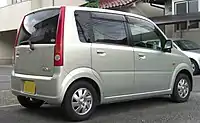 2002–2004 Daihatsu Move (L150S, pre-facelift)
2002–2004 Daihatsu Move (L150S, pre-facelift) 2002–2004 Daihatsu Move Custom (L150S, pre-facelift)
2002–2004 Daihatsu Move Custom (L150S, pre-facelift)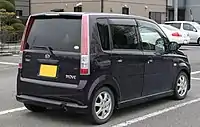 2002–2004 Daihatsu Move Custom (L150S, pre-facelift)
2002–2004 Daihatsu Move Custom (L150S, pre-facelift) 2004–2006 Daihatsu Move Custom (L150S, facelift)
2004–2006 Daihatsu Move Custom (L150S, facelift) 2004–2006 Daihatsu Move Custom (L150S, facelift)
2004–2006 Daihatsu Move Custom (L150S, facelift)
Fourth generation (L175; 2006)
| Fourth generation (L175) | |
|---|---|
 2006 Daihatsu Move (L175S, pre-facelift) | |
| Overview | |
| Production | October 2006 – December 2010 |
| Body and chassis | |
| Related | |
| Powertrain | |
| Engine | |
| Power output |
|
| Transmission |
|
| Dimensions | |
| Wheelbase | 2,490 mm (98.0 in) |
| Length | 3,395 mm (133.7 in) |
| Width | 1,475 mm (58.1 in) |
| Height | 1,615 mm (63.6 in) |
| Kerb weight | 810–930 kg (1,786–2,050 lb) |
The fourth-generation Move was introduced in October 2006 and its design was a departure from the boxy look of the previous generations. A KF-VE-type non-turbo engine and a continuously variable transmission (CVT) were available on this model. It has a derivative called Move Conte.
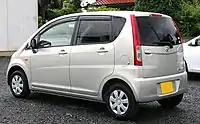 2006–2008 Daihatsu Move (L175S, pre-facelift)
2006–2008 Daihatsu Move (L175S, pre-facelift)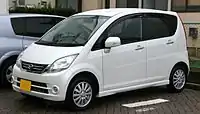 2008 Daihatsu Move (L175S, facelift)
2008 Daihatsu Move (L175S, facelift) 2006–2008 Daihatsu Move Custom (L175S, pre-facelift)
2006–2008 Daihatsu Move Custom (L175S, pre-facelift)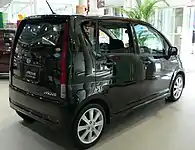 2006 Daihatsu Move Custom (L175S, pre-facelift)
2006 Daihatsu Move Custom (L175S, pre-facelift) 2008 Daihatsu Move Custom (L175S, facelift)
2008 Daihatsu Move Custom (L175S, facelift) 2008 Daihatsu Move Custom (L175S, facelift)
2008 Daihatsu Move Custom (L175S, facelift)
Fifth generation (LA100; 2010)
| Fifth generation (LA100) | |
|---|---|
 Daihatsu Move L (LA100S, pre-facelift) | |
| Overview | |
| Also called | Subaru Stella (second generation) |
| Production |
|
| Assembly | Japan: Ryūō, Shiga (Ryūō plant);[3] Nakatsu, Ōita (Daihatsu Motor Kyushu)[4] |
| Designer | |
| Body and chassis | |
| Related | Daihatsu Mira e:S (LA300) |
| Powertrain | |
| Engine |
|
| Power output |
|
| Transmission | CVT |
| Dimensions | |
| Wheelbase | 2,455 mm (96.7 in) |
| Length | 3,395 mm (133.7 in) |
| Width | 1,475 mm (58.1 in) |
| Height | 1,620–1,635 mm (63.8–64.4 in) |
| Kerb weight | 810–890 kg (1,786–1,962 lb) |
The fifth-generation Move was introduced in December 2010. The car is also sold by Subaru as the second-generation Subaru Stella (Japanese: スバル・ステラ, Subaru Sutera) through an OEM agreement.
- Daihatsu Move
 Daihatsu Move L 4WD (LA110S, pre-facelift)
Daihatsu Move L 4WD (LA110S, pre-facelift)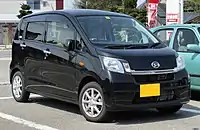 Daihatsu Move X SA (LA100S, facelift)
Daihatsu Move X SA (LA100S, facelift)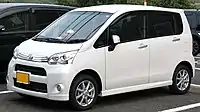 Daihatsu Move Custom X (LA100S, pre-facelift)
Daihatsu Move Custom X (LA100S, pre-facelift)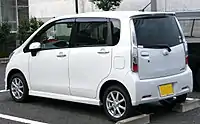 Daihatsu Move Custom X (LA100S, pre-facelift)
Daihatsu Move Custom X (LA100S, pre-facelift)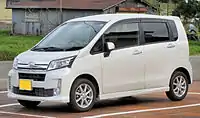 Daihatsu Move Custom X Limited SA (LA100S, facelift)
Daihatsu Move Custom X Limited SA (LA100S, facelift)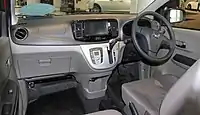 Interior
Interior
- Subaru Stella
_Front.jpg.webp) Subaru Stella L (LA100F, facelift)
Subaru Stella L (LA100F, facelift) Subaru Stella L Limited (LA100F, facelift)
Subaru Stella L Limited (LA100F, facelift) Subaru Stella Custom R (LA100F, pre-facelift)
Subaru Stella Custom R (LA100F, pre-facelift)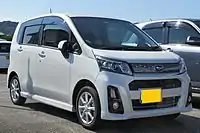 Subaru Stella Custom R SA 4WD (LA110F, facelift)
Subaru Stella Custom R SA 4WD (LA110F, facelift)
Sixth generation (LA150; 2014)
| Sixth generation (LA150) | |
|---|---|
_front.jpg.webp) Daihatsu Move X SA II (LA150S) | |
| Overview | |
| Also called | Subaru Stella (third generation) |
| Production | December 2014 – present |
| Assembly | Japan: Ryūō, Shiga (Ryūō plant);[3] Nakatsu, Ōita (Daihatsu Motor Kyushu)[4] |
| Body and chassis | |
| Related | Daihatsu Mira e:S (LA350) |
| Powertrain | |
| Engine |
|
| Power output |
|
| Transmission | CVT |
| Dimensions | |
| Wheelbase | 2,455 mm (96.7 in) |
| Length | 3,395 mm (133.7 in) |
| Width | 1,475 mm (58.1 in) |
| Height | 1,630 mm (64.2 in) |
| Kerb weight |
|
The sixth-generation Move was introduced in Japan in December 2014, along with the third-generation Stella. This generation features a lightweight high-rigidity body structure with a reinforced underbody, improved suspension system, and a power mode-switching steering switch that allows drivers to change the control of the engine and CVT at the touch of a button. It has a derivative called Move Canbus.
Fuel economy is claimed at 31 km/L (88 mpg‑imp; 73 mpg‑US) while turbocharged models (Custom models only) delivering 27.4 km/L (77 mpg‑imp; 64 mpg‑US).[10]
- Daihatsu Move
_rear.jpg.webp) Daihatsu Move X SA II (LA150S)
Daihatsu Move X SA II (LA150S)_front.JPG.webp) Daihatsu Move Custom X Hyper SA (LA150S, pre-facelift)
Daihatsu Move Custom X Hyper SA (LA150S, pre-facelift)_rear.JPG.webp) Daihatsu Move Custom X Hyper SA (LA150S, pre-facelift)
Daihatsu Move Custom X Hyper SA (LA150S, pre-facelift)_front.jpg.webp) Daihatsu Move Custom X Limited SA III (LA150S, facelift)
Daihatsu Move Custom X Limited SA III (LA150S, facelift)_rear.jpg.webp) Daihatsu Move Custom X Limited SA III (LA150S, facelift)
Daihatsu Move Custom X Limited SA III (LA150S, facelift)_interior.jpg.webp) Interior
Interior
- Subaru Stella
_front.JPG.webp) Subaru Stella G SA (LA150F)
Subaru Stella G SA (LA150F)_front.jpg.webp) Subaru Stella Custom RS SA (LA150F, pre-facelift)
Subaru Stella Custom RS SA (LA150F, pre-facelift)
International markets
In Malaysia, Perodua manufactures a version of the Move called the Kenari.
In China, the FAW Tianjin joint venture between First Automobile Works and Toyota produces a petrol and electrical version of the Move. The electric version is exported to the US as the Miles ZX40.
The first two generation Moves were also exported to Europe, where they also went by the Japanese market name. Due to poor sales, Daihatsu did not export the third or fourth-generation Moves to Europe after the brand's departure from the continent, making it strictly a Japanese domestic market model.
References
- 1 2 Caldera, Maurizio (19 May 1997). "Daihatsu Move, il coraggio di osare" [Daihatsu Move, the courage to dare]. La Repubblica (in Italian). Archived from the original on 7 July 2021.
- ↑ "ムーヴ(ダイハツ)の総合情報:型式 E-L602S" [Daihatsu Move general information: L602 type]. Goo-net (in Japanese). Proto Corporation. Retrieved 24 September 2013.
- 1 2 "Facilities|Company|DAIHATSU".
- 1 2 "Notice Regarding the Operation of Domestic Plants (as of May 18)" (PDF). Daihatsu Motor Co., Ltd. 18 May 2020.
- ↑ "DJKI | E-Status". pdki-indonesia.dgip.go.id.
- ↑ Billy (13 September 2011). "Mark Widjaja, Mobil dengan Simple Design Tak Pernah Usang" [Mark Widjaja: A Car with Simple Design is Never Outdated] (in Indonesian). Otomotifnet.com. Archived from the original on 13 July 2019.
- ↑ "Mark Widjaja: Soal Desain Mobil, Jangan Remehkan Indonesia" [Mark Widjaja: The car design question: Don't underestimate Indonesia] (in Indonesian). Kompas Gramedia. 8 May 2017.
- ↑ "Sttt.. Desainer Ayla Pernah Tak Naik Kelas" [Ayla's Designer Had Used to Failed Grades]. Okezone (in Indonesian). Indonesia. 6 November 2012. Retrieved 16 July 2019.
- ↑ "DJKI | E-Status". pdki-indonesia.dgip.go.id.
- ↑ "ダイハツ 新型ムーヴ(2014年フルモデルチェンジ)発表会速報". autoc-one.jp.
External links
- Official website (Move)
- Official website (Move Custom)
- Official website (Stella)